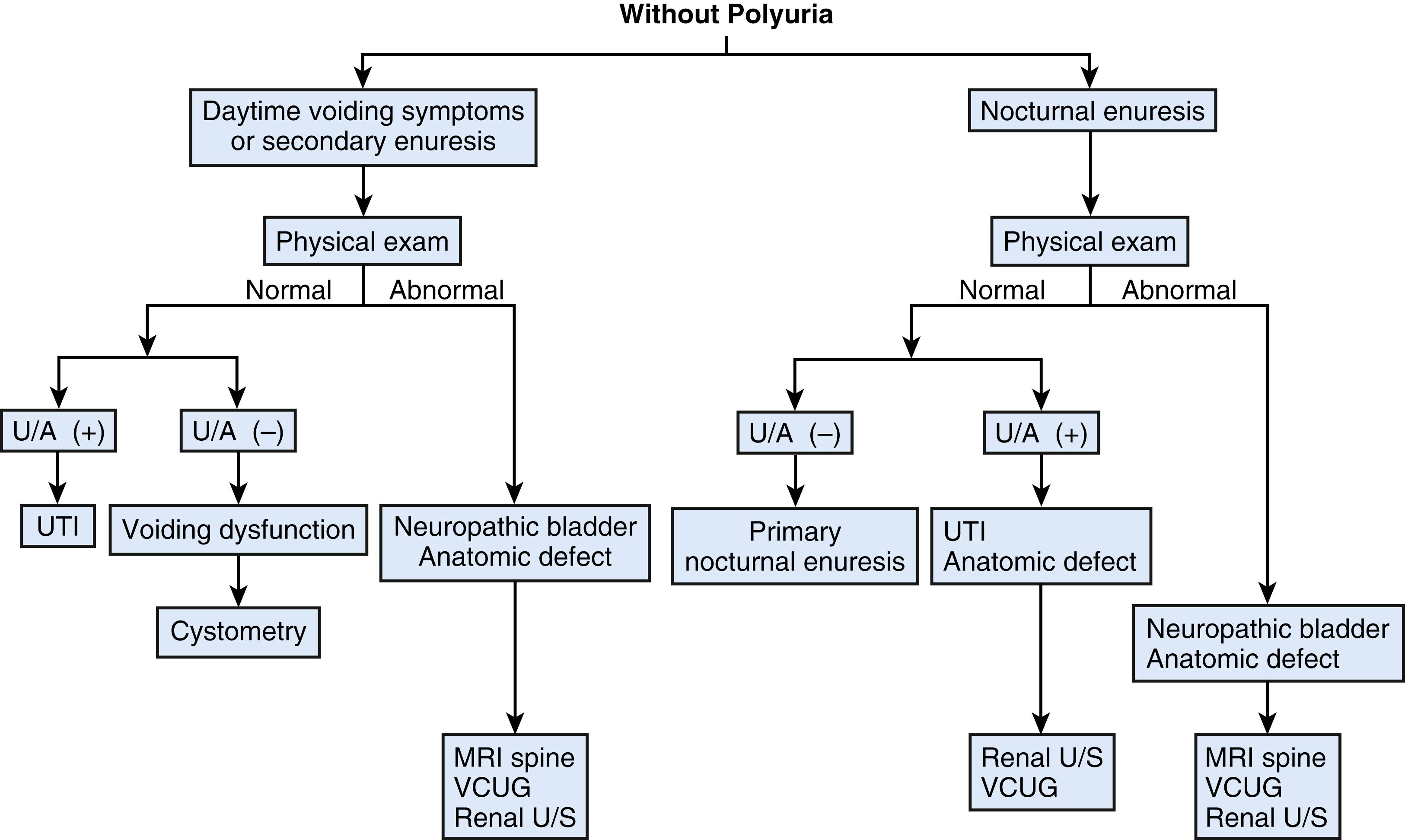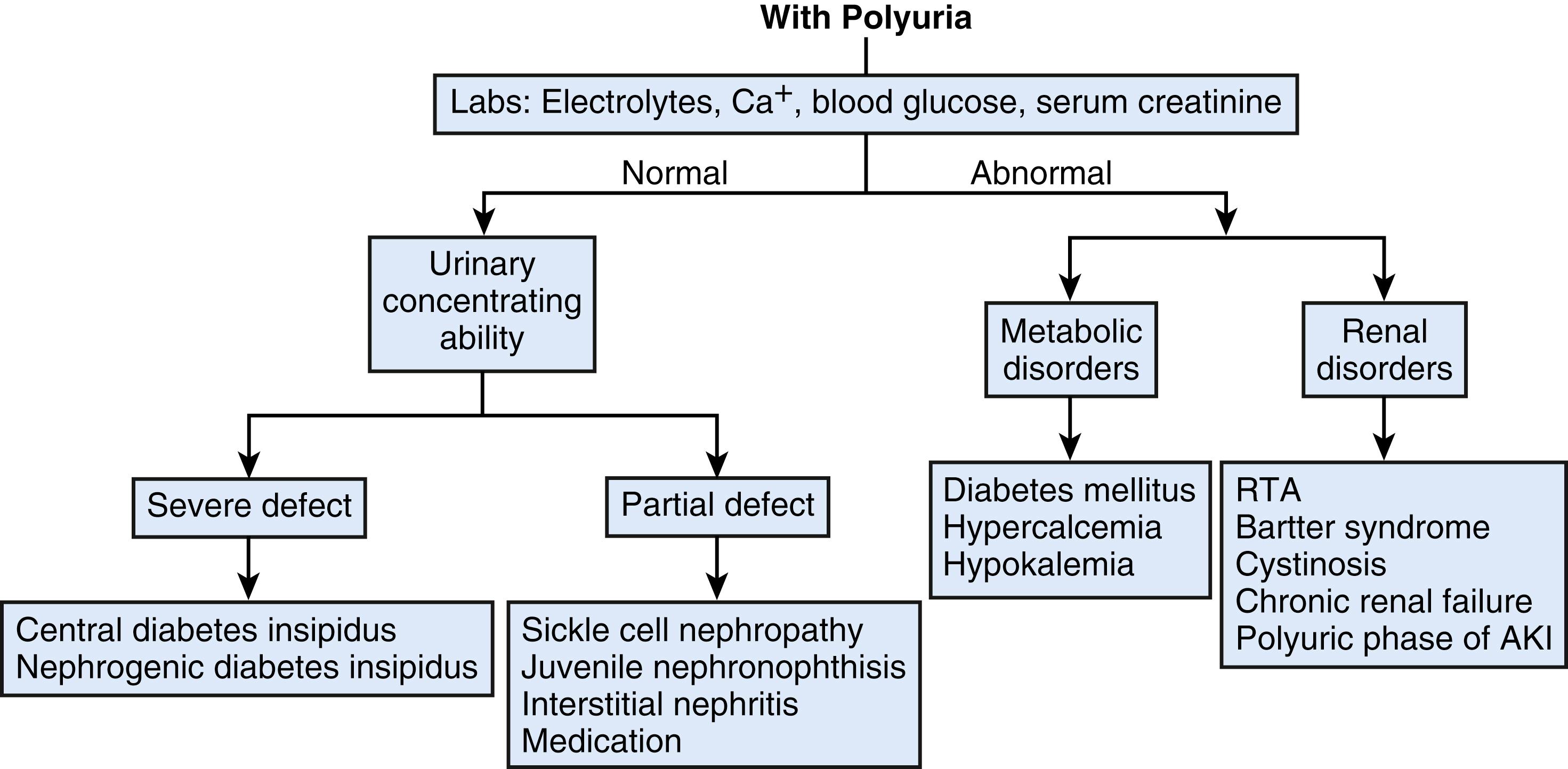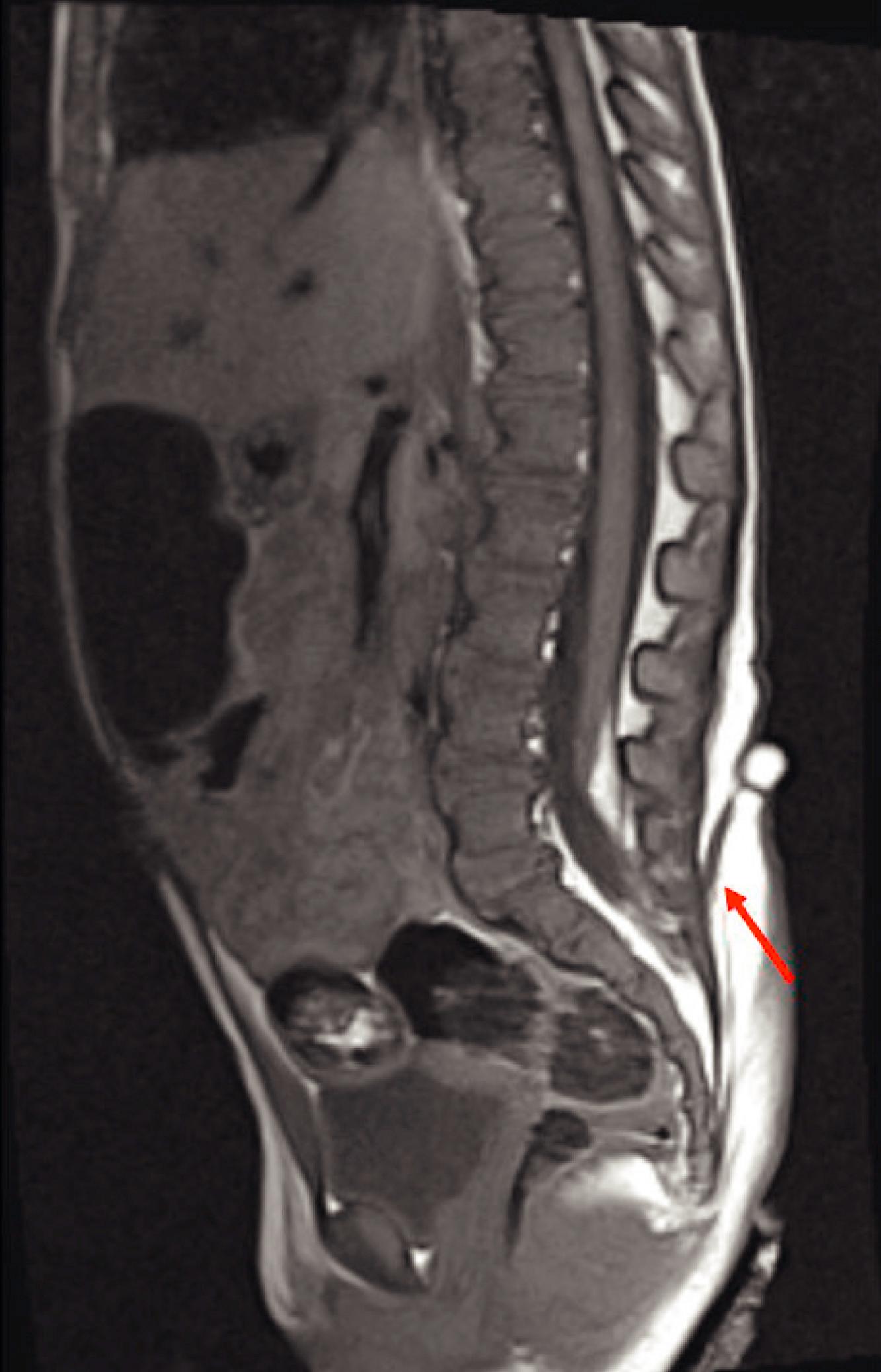Physical Address
304 North Cardinal St.
Dorchester Center, MA 02124
Urinary incontinence is a normal developmental stage. When present beyond a certain age defined by parental and societal expectations, it can cause concern and anxiety in the patient and family. Urinary incontinence can also be a symptom of significant pathologic processes. The challenge to the clinician is identifying the child with an organic disorder among the many who are proceeding along a normal developmental track.
Urinary continence is dependent on normal bladder function and normal urine production. Normal development of bladder function results in the storage and release of urine in a socially and physically acceptable way. During storage, the detrusor muscle is relaxed, and the capacity of the bladder allows urine to be held for several hours. Micturition is then voluntary, with coordinated detrusor contraction and sphincter relaxation, resulting in complete bladder emptying. The bladder capacity in children learning to be toilet trained is variable, being dependent on their own sensation of bladder fullness. The maximum functional bladder capacity may differ greatly among children when measured by home diaries. Cystometry, a method of measuring bladder volume, can be estimated by the following formula:
In children 2 years of age or older:
Although the innervation of the bladder is predominantly autonomic, bladder function is under control of cortical function. Thus, a complex integration of visceral and somatic innervation is necessary for normal voiding, which perhaps explains the wide spectrum in the ages for urinary continence. Parasympathetic neural activity provides the primary input during micturition, leading to relaxation of the urethral smooth muscle and initiating detrusor contractions. Pelvic nerves conducting parasympathetic activity form a reflex arc with the centrally located pontine micturition center. The thoracolumbar sympathetic branch, via hypogastric and pelvic sympathetic nerves, innervates the detrusor to relax and the urinary sphincter to contract during urine storage.
Urinary continence thus relies on the abilities to (1) store urine without leakage, (2) release urine voluntarily and completely, and (3) interrupt micturition voluntarily. The third ability is indicative of fully coordinated cortical-autonomic function.
The age at which toilet training is achieved is influenced by cultural factors as well as psychosocial factors. The achievement of daytime urinary continence follows the attainment of bowel control. There is evidence that the age of daytime and nighttime continence has increased worldwide in the past century. Data suggest a change in parental attitudes toward the toilet training process and their expectations. Among social factors reported, children of single parents are successfully toilet trained at an earlier age, whereas enrollment in daycare does not have a significant influence. There is no consensus on age of readiness for toilet training in Western society. Nearly two dozen signs of readiness have been reported, but no evidence-based studies are available to indicate which readiness signs and how many are needed for a child to successfully toilet train. Consistent predictive factors include that females are toilet trained earlier than males and Black children are trained earlier than White children. Techniques for toilet training are varied and range from the child-oriented approach to single-day training intensive methods to the use of daytime wet alarms.
Polyuria is the overproduction of urine. Polyuria is a symptom that is fixed and therefore occurs during both the daytime and the nighttime. “Nocturnal polyuria,” a symptom proposed in a subset of patients with primary nocturnal enuresis, is discussed separately. Overproduction of urine indicates a defect in one of several mechanisms regulating water and solute homeostasis. Identification of children with incontinence caused by polyuria is essential for diagnosing a variety of disorders ( Table 58.1 ).
| With Polyuria |
|
| Without Polyuria |
|
Urine production varies depending on the intake of fluids and solute, activity, caloric expenditure, and the environment. The volume reflects the maintenance of normal fluid and electrolyte balance (1) through the regulation of plasma osmolality by vasopressin and through the thirst mechanism and (2) by the regulation of extracellular volume and solute (mainly sodium) homeostasis by the kidney. The sensation of thirst occurs when plasma osmolality rises above a threshold of 280–290 mOsm/L. Release of vasopressin, a peptide produced by the hypothalamus, parallels the sensation of thirst and then acts on receptors in the collecting ducts of the kidney to diminish water excretion and to concentrate the urine. Hypovolemia is also a stimulant for vasopressin. Once serum osmolality is restored to normal, vasopressin release is inhibited, and renal water excretion increases. Maintenance of extracellular fluid volume depends on sodium homeostasis and directly affects urine volume. It involves the interaction of several systems, including (1) the renin-angiotensin system, (2) the atrial natriuretic peptide, and (3) the sympathetic nervous system.
Among patients with primary nocturnal enuresis, there is a subset of patients with “nocturnal polyuria,” in which larger volumes of more dilute urine are produced than in patients who remain dry. Responsiveness to the administration of vasopressin analogs, such as desmopressin acetate (1-deamino[8- d -arginine] vasopressin [DDAVP]), differentiates such patients into responders and nonresponders.
The history should begin with determining if urinary incontinence is limited to primary nocturnal enuresis versus daytime urinary incontinence (DUI). The next step is to inquire whether it is primary or secondary. Primary nocturnal enuresis is considered a separate disorder and unlikely to have organic etiology, whereas the determination of secondary nocturnal enuresis or secondary DUI should call for careful evaluation. Questions to determine whether the patient has polyuria are important as the presence of polyuria suggests a variety of metabolic, systemic, and kidney diseases. The absence of polyuria directs more focus on the lower urinary tract ( Table 58.2 ; see also Table 58.1 ).
| Acquired |
|
| Congenital |
|
Polyuria, the excessive production of urine, can result from the absence of release of antidiuretic hormone (ADH), failure of the kidney to respond to ADH, or an osmotic diuresis. This can lead to urinary incontinence, especially in young children. Polyuria always results in polydipsia. It is often easier to query parents as to whether the volume of fluid intake by the child is excessive rather than to obtain an estimate of the volume of urine output. The first clue to polydipsia in infants is irritability and “hunger” after a successful feeding of formula or breast milk. In young children, favoring water over solids or milk, as well as seeking water in unusual places (e.g., toilets), can be a sign of polydipsia. Waking to seek fluids at night in a consistent pattern is also a sign of polydipsia. Parental stories of bed linens being soaked despite a “double diaper” or training pull-on diaper are remarkable, especially when recounted by experienced parents.
An osmotic diuresis leading to polyuria may be an early sign of diabetes mellitus. The previously dry child may develop secondary nocturnal or even daytime enuresis. Associated symptoms include polydipsia and polyphagia with poor weight gain and fatigue. Children with central diabetes insipidus (CDI) and the genetic forms of nephrogenic diabetes insipidus (NDI) produce very large amounts of hypotonic urine. Along with polyuria and enuresis, these children may have a history of frequent hospitalizations for dehydration, often provoked by relatively minor illnesses. The dehydration is often associated with moderate or severe hypernatremia. Failure to thrive may develop because of a preference for low-calorie-containing fluids over solid foods. The secondary causes of NDI may include a partial defect in the mechanism for renal concentrating, and urinary incontinence may be the only symptom (see Table 58.2 ). Conversely, other children may also have growth retardation because of associated chronic renal failure or the associated metabolic abnormalities (e.g., metabolic acidosis in renal tubular acidosis [RTA] or rickets in Fanconi syndrome, metabolic alkalosis in Bartter syndrome). Polydipsia can also result from a behavioral problem and result in polyuria, but patients will demonstrate normal urinary concentrating ability using appropriate testing.
In the presence of enuresis but the absence of polyuria, a voiding history helps to determine whether additional evaluation is warranted. Is the urinary incontinence nocturnal only, or is daytime incontinence also present? Does the patient have stool incontinence? Voiding frequency is sometimes difficult to ascertain in a school-age child, and an assignment to keep a diary of voiding can be given on the first visit. This should include information on both bladder and bowel habits, specifically urine volumes and when urinary incontinence occurs. Voiding postponement, or urine holding patterns, with overflow incontinence is most easily identifiable with a diary. Incontinence can be a symptom of a urinary tract infection (UTI) (see Chapter 21 ). Associated symptoms may include dysuria, frequency, and urgency. Other urinary symptoms such as dysuria, urgency, dampness in the underwear, or other signs of UTI can all be signs of voiding dysfunction. Asking parents for specific observations—such as (1) the sudden urge to void followed by incontinence or (2) maneuvers to prevent urine leakage, such as squatting and pressing the heel of the foot into the perineum—elicits clues to a hyperactive detrusor muscle. Incontinence may occur with giggling, with physical stress while jumping, or with activities that require Valsalva maneuvers.
Secondary enuresis is defined as enuresis occurring after a dry period of at least 6 consecutive months and can be the first sign of an acquired renal or metabolic disease. Fecal soiling or constipation may be an accompanying sign of voiding dysfunction, but it should first raise suspicion for an occult spinal lesion such as spina bifida or a tethered cord. In addition, continuous dribbling, a poor urinary stream, or recurrent infections may be a sign of anatomic or neuropathic lesions (see Table 58.1 ).
The patient with nocturnal enuresis (bedwetting) is typically without any major daytime symptoms. Enuresis is considered primary when the patient has not had any dry periods for >6 months. Toilet training for daytime control is often achieved easily. The frequency of wet nights should be ascertained to gauge the magnitude of the problem. Approximately 5–10% of 7-year-old children are affected and for some the problem persists into adolescence and even adulthood. A family history of nocturnal enuresis increases a patient’s risk for nocturnal enuresis. If both parents have a history of enuresis, the rate of occurrence in offspring may be as high as 70–80%. If the father had primary nocturnal enuresis, the child has a fivefold to sevenfold increase in risk. The pathophysiologic mechanism is multifactorial; explanations include defects in osmoregulation (nocturnal polyuria), nocturnal detrusor over-reactivity, and disorders of sleep or arousal states.
Social stressors should be ascertained because psychologic factors are important in the occurrence of secondary enuresis. There are reports of other psychiatric issues, such as attention-deficit/hyperactivity disorder, autism, and conduct disorders, associated with a higher incidence of daytime and nighttime incontinence. It has been widely accepted, however, that many affected children are often emotionally well adjusted. Nonetheless, care should be taken not to underestimate the sequelae of both enuresis and DUI in the older school-age child, who may feel “abnormal” among peers. Evaluation of the patient should always include inquiring how the patient and other family members are reacting to the problem and whether it may be interfering socially, with school issues, and with quality of life.
Finally, primary nocturnal enuresis may be a sleep disorder or a disorder of arousal. Patients with severe nocturnal enuresis may have defects in arousal to auditory stimuli. Inquiry into symptoms of sleep apnea should also be made, such as snoring or restless sleep, as it may lead to altered arousal states, leading to nocturnal enuresis in patients with sleep apnea (see Chapter 6 ).
In all affected patients, their growth should be evaluated, because failure to thrive can be seen in many of the metabolic disorders that produce polyuria. The presence of hypertension suggests underlying renal or urologic abnormalities. Careful evaluation of the lower back may reveal cutaneous abnormalities such as hair tufts, pits, dimpling, or vascular malformations, which are possible signs of spina bifida occulta or tethered cord. A significant deviation of the gluteal cleft may also suggest the possibility of spinal dysraphism. The abdominal examination is important for detecting a distended bladder, suprapubic tenderness, or significant stool retention. A neurologic examination should include assessment of lower extremity deep tendon reflexes, observation of the gait, and evaluation of perineal sensation and anal sphincter tone, again screening for the possibility of a neuropathic bladder. Anatomic abnormalities leading to incontinence should be sought by inspection of the genitalia. In females, the examination includes a search for fused labial folds and dribbling urine from an ectopic ureter. In males, the phallus should be inspected for the presence of epispadias or undescended testicles.
The presence or absence of polyuria helps guide the necessary laboratory and radiologic testing ( Figs. 58.1 and 58.2 ). An immediate UA is critical for differentiating the glycosuria of diabetes mellitus from the low specific gravity (osmolality) of diabetes insipidus or the proteinuria and/or hematuria of chronic renal disease.


A water deprivation test to examine urine concentrating capacity of patients when diabetes insipidus is suspected should be done in a hospital setting, with close observation of and attention to urine and serum osmolarity, urine output, and weight loss. In patients with significant polyuria, dehydration and hyperosmolarity are easily precipitated with several hours of water deprivation. For patients with a less suspect history of polyuria, a first morning void after an overnight fast should be sufficient for checking urine osmolarity or specific gravity.
In some patients, the problem can be better defined with a home voiding diary, which outlines how often and how much they are voiding and when urinary incontinence, constipation, or encopresis occurs.
Routine laboratory examination in patients with monosymptomatic nocturnal enuresis includes a UA and then is diagnosed by taking a good history and performing a complete physical examination. In patients with DUI or secondary nocturnal enuresis, or when polyuria or polydipsia is present, a screening UA, followed by appropriate blood chemistry studies, is important for evaluating for diabetes mellitus or electrolyte disorders such as metabolic acidosis (RTA), metabolic alkalosis (Bartter syndrome), hypercalcemia, and hypokalemia. Hypernatremia can be seen in the severe forms of diabetes insipidus. UTI should be sought in most patients with incontinence by obtaining a UA and urine culture. A UA also helps screen for occult, chronic glomerular or tubular renal disease. Hematuria or proteinuria can be a sign of renal disease, although its absence does not exclude this possibility. Glycosuria, when associated with normal serum glucose, can indicate tubulointerstitial disease, where proximal tubular injury results in a lowered threshold for glucose reabsorption.
Radiologic imaging is not necessary in most patients with primary nocturnal enuresis. In select patients with secondary enuresis, daytime symptoms, or a suspect history or UA, renal ultrasonography may provide information regarding acquired or congenital renal diseases. Images of the bladder can reveal urologic abnormalities, including poor bladder emptying or thickened bladder wall. A voiding cystourethrogram is indicated only in patients with a questionable urinary stream, continuous dribbling (aberrant ectopic ureter), or suspected spinal cord lesions with lower extremity neurologic signs. MRI of the lower spine should be reserved for patients with cutaneous signs, neurologic or orthopedic symptoms of the lumbar-sacral spine, or complex spinal bone deformities seen on plain radiographs ( Table 58.3 and Figs. 58.3 and 58.4 ). All patients with CDI must undergo cerebral MRI with specific focus on the hypothalamic-pituitary region.
| Imaging Indicated |
|
| Imaging Uncertain |
|
| Imaging Not Required |
|


Cystometry examination is useful for a select group of patients with a history of dysfunctional voiding symptoms whose response to therapy is poor. Bladder instability is characterized by involuntary contractions at more than 15 cm of water pressure during filling. Small bladder capacity is almost always a functional problem, not anatomic.
Primary nocturnal enuresis (bedwetting) is considered abnormal in most social contexts after the age of 5 years. In the Diagnostic and Statistical Manual of Mental Disorders , fifth edition (DSM-5), primary enuresis is defined as wetting clothes or the bed at least twice a week for more than 3 consecutive months. Most affected patients have no daytime symptoms. It is a common problem, but only a small proportion of patients seek medical advice. The incidence of pure primary nocturnal enuresis without other symptoms is twice as common among males as among females.
Become a Clinical Tree membership for Full access and enjoy Unlimited articles
If you are a member. Log in here